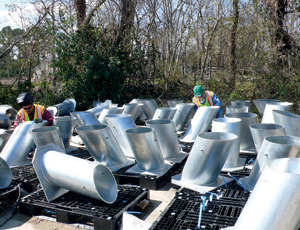...precast-concrete cofferdam that could be placed quickly with conventional cranes above the water level, then lowered, dewatered and filled with concrete, Brown says.

The horizontal crossbeams of the H-frames are constructed in 13-ft lifts of 7,000-psi concrete. “We want the early strength so we can jump the forms as quickly as possible,” Daams says. “This mix gets to 3,000 psi in about 12 hours.”
IHI Inc., New York City, is supplying all the steel girders for the main span, Daams says. Dunham Price, Westlake, La., is making all the concrete piles, girders and precast-concrete decking.
As its first and largest design-build job to date, the project is inherently challenging for the La.DOTD, says Jim Wiley, quality-assurance and project manager for Louisiana TIMED Managers, which is a joint venture of GEC Inc., Metairie, La., PB Americas Inc., New York City, and The LPA Group Inc., Columbia, S.C. The joint venture was hired in 2002 by the DOTD to assist the state with its $5-billion Transportation Infrastructure Model of Economic Development program. TIMED was created by the state Legislature in 1989 to deliver 16 key projects in 27 of the state’s 64 parishes. La.DOTD hired LTM 13 years after the Legislature authorized the program to perform program management, bond the remainder of the program and accelerate the 2031 completion date.
“Anytime you have a project with a new approach, it takes a while for everyone to work together as a team,” says Wiley, who has led “first” design-build projects in other states. To facilitate the design build process among all the team partners, the DOTD and ABC established a dispute-resolution board (DRB), the first in the state, Wiley says. “When there is a dispute we can’t resolve, it goes to the DRB, kind of like a hearing,” he says. The DRB makes a recommendation, and in most cases each party accepts that, Wiley says. “It’s a tool used in design-build to help us resolve issues and keep going.”
The workforce for the John James Audubon Bridge project employed up to 300 people at peak last November, of which 200 were crafts workers.

Post a comment to this article
Report Abusive Comment